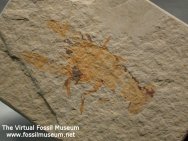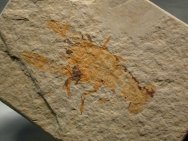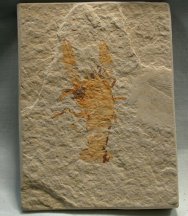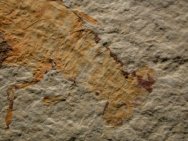 Description:
This 50 million year old, Eocene-Era fossil crayfish comes from
one of the world's famous Laggerstatten, the Green River Formation
in Wyoming. A small portion of the fossils from Green River exhibits
such fine preservation. Most fossils offered are various fish, but
other fossils are also found. Description:
This 50 million year old, Eocene-Era fossil crayfish comes from
one of the world's famous Laggerstatten, the Green River Formation
in Wyoming. A small portion of the fossils from Green River exhibits
such fine preservation. Most fossils offered are various fish, but
other fossils are also found.
This crayfish has wonderful details present, and
represents the finest degree of preservation. Notice that ebven
the annulation of the antennae is evident. Crayfish have a spotty
fossil record beyond 30 million years, but Procambarus from the
Green River Formation and Palaeocambrus from the Yixian Formation
of China are exceptions.
About the Green River Formation: Class Actinopterygii,
the ray-finned bony fishes, comprise almost half of all known species
of vertebrates, some 20,000 extant species. There are numerous locations
worldwide that are noted for wondrous preservation of bony fishes,
and the Green River formation that covers some 25,000 square miles
of SW Wyoming, west Colorado and east Utah is one of the premier
examples. The formation is one of the largest lacustrine sedimentary
accumulations in the world, and spans the period from 40 to 50 million
years ago during the Eocene Epoch.
During the Eocene, based on the fossil record, the
region was sub-tropical to temperate. Some 60 vertebrate taxa have
been described from the formation, including crocodiles, boa constrictors,
and birds, as well as abundant invertebrates and plants. The unusually
excellent preservation of the Green River fossils is usually attributed
to a combination of two factors: 1) a cold period during the Eocene
that would have caused dead fish to sink faster due to a less inflated
swim bladder; and 2) the great depth of the lakes and the consequent
anoxic conditions that would have often prevented scavengers from
disturbing the carcasses. |




